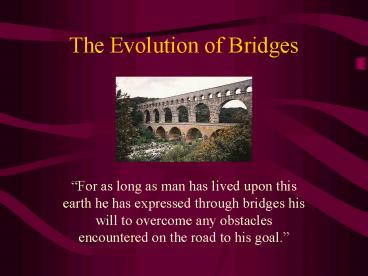The Evolution of Bridges - PowerPoint PPT Presentation
1 / 16
Title:
The Evolution of Bridges
Description:
Development Cantilever construction and Travelling formwork techniques. ... Wooden framework, Cantilever construction and travelling formwork. Perceived ... – PowerPoint PPT presentation
Number of Views:155
Avg rating:3.0/5.0
Title: The Evolution of Bridges
1
The Evolution of Bridges
- For as long as man has lived upon this earth he
has expressed through bridges his will to
overcome any obstacles encountered on the road to
his goal.
2
Outline
- History of Bridges
- Design Style
- Perceived Environments
- Patterns of innovation
- Technology Push
- Market Pull
3
History of Bridges
- Pre-civilisation bridges Beams fallen across a
stream. -gt Rope bridges - 2000 BC According to Chinese tradition,
stationary bridges existed in this period. - 493 BC Timber (pontoon) bridges used during
Persian military campaign. - Early Roman Stone arch bridges, wooden framework
used to hold the incomplete bridge. Use of
concrete. - 16th 18th Century After the collapse of Roman
empire, no advance in bridge building. During the
Renaissance advances in architecture and
engineering.
4
History of Bridges (2)
- 18th 19th Century Use of iron cables in
suspension bridges and iron beams also used for
the first time. - 19th - 20th Century Mass production of steel
begun. First suspension bridge which used steel
cables by Johann Roebling. Use of concrete begun. - 1879 Tay Bridge disaster at Firth of Tay at
Dundee. - 20th Century Steel replaced iron. Reinforced
concrete bridges became common. Development
Cantilever construction and Travelling formwork
techniques. - 1940 Tacoma Narrows Bridge disaster in city of
Tacoma due to wind-induced oscillation.
5
Design Style
- The design of bridges has been mostly
evolutionary with some revolutionary design. - Evolutionary Timber bridges covered in order to
protect them from the weather. - Revolutionary Introduction of use of stone.
6
Perceived Environments (1)
- Intrapsychic Environment
- Concept of bridges readily available in nature.
- Will to overcome obstacles.
- Rope bridges predecessors of modern suspension
bridges.
7
Perceived Environments (2)
- Construction/Manufacture Environment
- Early rope bridges were easy to build as they
only required a rope to be secured at both ends. - As the demands for more sophisticated bridges
increased, construction techniques evolved. - Wooden framework, Cantilever construction and
travelling formwork.
8
Perceived Environments (3)
- Adoption Environment
- Bridges, in general, were needed by communities,
countries and empires, so they were easily
salable. - Initially, reinforced concrete bridges failed in
this environment as they were not as
aesthetically pleasing as stone bridges.
9
Perceived Environments (4)
- Use Environment
- Bridge builders can design bridges for todays
use. - However, it has been difficult to predict
bridges future use. For example, increased loads
and, particularly, the change from one lane
traffic to two lane traffic due to invention of
automobiles.
10
Perceived Environments (5)
- Failure Environment
- Bridges cannot fail!
- Possibly, severe loss of life and money.
- Collapse of Tacoma Narrows Bridge
- Loss of 6.4 million and death of a dog.
- The Tay Bridge disaster
- Loss of train full of 75 passengers.
- Maintenance in the form of regular checkups and
paint for iron and steel bridges.
11
(No Transcript)
12
Perceived Environments (6)
- Scrapping Environment
- Material from the bridges can be used again.
- Or the bridge itself can be recycled. (DHV Dutch
office) - Political/Ecological environment
- May ruin beauty of countryside.
13
Patterns of Innovation
- More of the same
- Increased spans, heavier loads, and reducing
wastage of materials and construction time. - Passing over of quantity into quality
- Evolution of modern suspension bridges from rope
bridges. - Knights move
- Roman stone arch bridges.
14
Technology Push
- Charm
- Will to overcome obstacles.
- Feasibility
- Full support from people as bridges have been
vital in early and modern civilisation. Wood and
stone naturally available. - Belief that market exists
- Initially, small communities. Then, whole
countries and empires.
15
Market Pull
- There has always been a market pull for bridges.
They were invented because there was need to
cross an obstacle. - Market pull has been increasingly rapidly due to
- Exploration
- Trade
- Colonisation
- Railroads
- Automobiles and motorways.
16
Conclusion
- Unlike other inventions, bridges always had a
market pull from the beginning. - From trees and logs fallen across a stream to
modern suspension bridges. Where now? - Use of composite materials and polymers may make
bridges lighter, longer and stronger. Spans of
1km may be achieved.































